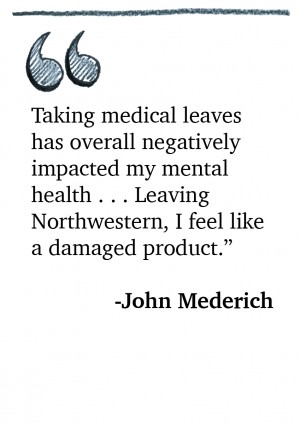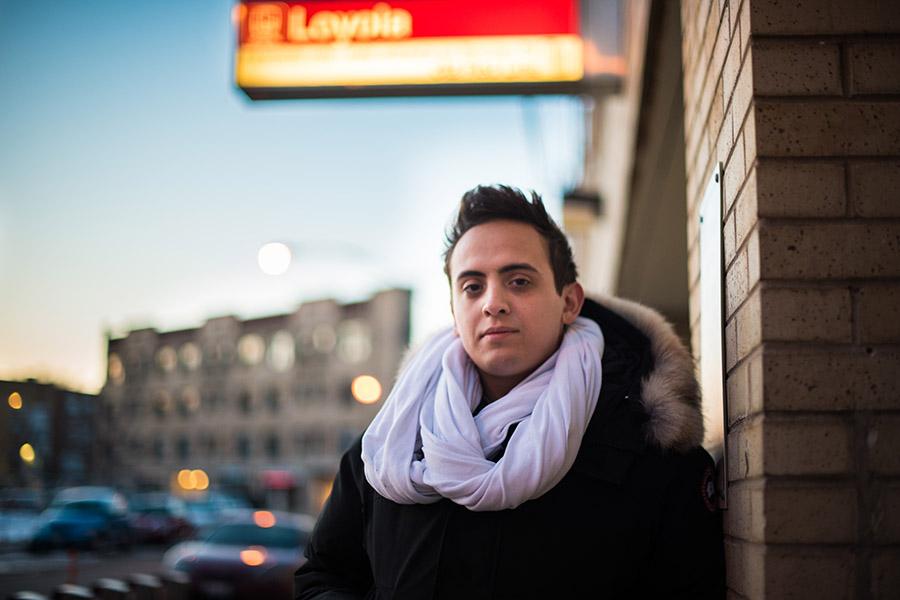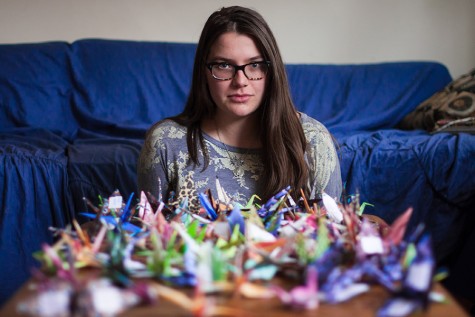In Focus: For students dealing with mental health issues, medical leave process presents obstacles
March 4, 2016
John Mederich experienced his first mental breakdown in October 2013.
A report on the incident described a volatile scene. According to medical records obtained by The Daily, a friend became worried when Mederich began acting strangely, “furious, ranting, raving.”
“He started sobbing, and said that he was suicidal, ‘I don’t want to live on this planet anymore.’, (sic) and ‘I’m going to stab myself,’” a staff member at Counseling and Psychological Services wrote about the friend’s report.
The friend told a security guard at Foster-Walker Complex she was concerned for Mederich’s safety. University Police escorted Mederich to the hospital, where he said he was hospitalized for about a week.
About three weeks later, he was hospitalized again. A CAPS psychiatrist recommended he take a medical leave, but he said he wasn’t ready. A little more than two months later, Mederich requested a leave, citing “issues adjusting to my sophomore year at Northwestern due to substance abuse issues that related to my mental health,” records show. His request was then granted.
Mederich has spent the majority of the time since then on three medical leaves, totaling about a year and a half. After suffering a psychotic breakdown in September 2015, Mederich took his last leave in October.
He hasn’t been back since.
Unlike some universities, taking a medical leave at NU is voluntary, administrators said. Staff members from CAPS and the Dean of Students Office said the majority of students return from leave happier and healthier.
Administrators said the stigma around taking a medical leave, however, is still a barrier to students receiving the support they need. Mona Dugo, senior associate dean of students in Student Assistance and Support Services, an office within the Dean of Students Office that helps students navigate university resources, told The Daily the Dean of Students Office is discussing ways to make students’ return to school smoother after taking a medical leave.
Some students who have taken medical leave for mental health issues said although the treatment they received was beneficial, the medical leave process wasn’t easy. They said intensive treatment plans, stigma about taking time off and a system not always sensitive to their needs were all barriers to what they wanted out of their medical leave experience.
Mederich applied to transfer to Loyola University Chicago in November. He started classes in January, majoring in communication studies and minoring in gender studies. Loyola is close to home — Mederich commutes from Rogers Park, where he lives with his parents.
In records obtained by The Daily, an October 2015 letter from Dugo, who said she is unable to comment on individual students’ experiences due to privacy laws, shows if Mederich were to return to NU he would not be able to do so until Winter Quarter 2017 “at the earliest.” Mederich said it isn’t worth it.
Diagnosed with “depression with features of psychosis,” Mederich has always struggled with his mental health. But he said the University’s expectations for treatment and maintaining sobriety were unrealistic and made returning to school more difficult. Overall, Mederich said the medical leave process has left him with a lot of “what ifs.”
His medical leaves had a pattern: Following mental health issues at the beginning of the school year, he would take a medical leave, only to return and struggle to readjust to life at NU. The process would then begin again.
“No one mentioned the pattern,” he said. “It was more so myself who had to come up with that conclusion. It was like after (the third) medical leave that I was like, ‘I’m done with NU because I can’t put myself through this anymore.’”
Mederich said although he appreciated the support he received, he felt himself lose control over his treatment process.
“Taking medical leaves has overall negatively impacted my mental health,” he said. “Leaving Northwestern, I feel like a damaged product.”
Policies and procedures
A typical medical leave lasts two quarters. There is no limit to how many medical leaves a student can go on, although if a student chooses to take more than one leave for the same reason, their subsequent leaves usually last at least a full academic year, Dugo said. The Dean of Students Office coordinates the medical leave and reinstatement processes.
Dugo said she estimates more than 90 percent of medical leaves are mental health related. She said there were 42 medical leaves in Fall Quarter. According to the Winter Quarter 2016 Division of Student Affairs Deans’ Update, which details new Student Affairs initiatives, there were 137 total medical leaves in the 2014-15 academic year. The previous year, there were 130.
Source: Student Assistance and Support Services
Dugo said students sometimes request medical leave independently, but are usually referred to the Dean of Students Office by CAPS or their academic dean or adviser.
Students’ transcripts do not show they were enrolled at NU during the quarter(s) they choose to take leave, Dugo said, including when a student leaves mid-quarter. The cut-off for students to apply for leave mid-quarter is typically the Friday of the eighth week of the quarter.
Students who go on medical leave receive a refund of their tuition if they withdraw mid-quarter, Dugo said.
 “That’s a big incentive,” she said. “Not only do (students) get to save themselves academically, they get the money back, get kind of a reset when they’re coming back and feeling better.”
“That’s a big incentive,” she said. “Not only do (students) get to save themselves academically, they get the money back, get kind of a reset when they’re coming back and feeling better.”
For mental health-related medical leaves, the Dean of Students Office defers to CAPS for referrals to outside treatment providers. Dugo said CAPS also works with students’ insurance providers to ensure students can afford treatment.
Students must meet with CAPS before going on leave for mental health issues, said Dr. John Dunkle, executive director of CAPS, in an interview with The Daily.
When a student is on leave, completion of a specific treatment plan is a requirement for reinstatement, Dunkle said. The reinstatement process also includes an application and a re-entry interview.
“We talk to them about what the recommendations are and the students review it, usually with their family,” Dunkle said. “It’s usually therapy of some sort … it may be medication, it may mean group therapy, it may mean a whole host of things.”
A balancing act
Emily Comstock was struggling. A member of the fencing team on the pre-med track, the then-Weinberg freshman was doing 11 hours of therapy in an intensive outpatient program each week on top of practice, class and schoolwork. Comstock dealt with depression, anxiety and an eating disorder in high school, and after several sessions with CAPS in Fall Quarter 2013, her psychologist recommended outside help at an Evanston treatment facility, records show.
Comstock suffered a mental breakdown that November. She vividly remembers sitting in Sargent dining hall for a Thanksgiving meal with her teammates, who were discussing calorie counts.
“Everybody was talking about losing weight and counting calories and counting carbs and I was like, ‘You guys are literally killing me, I can’t deal with this,’” she said.
Comstock returned to her room in Bobb Hall and started to cut her wrists with a razor. She went to fencing practice that night in tears.
The next day, Comstock met with her psychologist and was admitted to a psychiatric ward in Highland Park where she stayed for 11 days. She requested a medical leave in December and did a partial hospitalization program until February 2014, when she returned to her home in Arizona. Comstock returned to NU in September 2014, records show.
Today, Comstock says treatment “saved her life.” But although she’s grateful CAPS helped her find treatment, she said she wishes the University would have recognized her needs and made accommodations for her busy schedule, like letting her skip fencing practice for a day.
“I was working myself into the ground every day,” she said. “It wasn’t like I was looking for a special favor, I was just looking to level the playing field.”
Comstock said although her medical leave process was smooth — “It was easy to get out” — CAPS should have communicated better with the athletic department, she said, “to make sure there was a safety net for me, to make sure that it didn’t have to get that bad for me to have to say stop.”
Tory Lindley, director of athletic training services, said the communication in a medical leave situation is driven by the student-athlete. He said there is ongoing communication between the athletic team’s physician, the athletic trainer, the student-athlete and CAPS or other mental health treatment providers.
“There’s a really unique, positive environment in athletics given the fact there’s a number of people around our student-athletes all day,” he said. “But we also educate our athletes every year that they don’t need one of us and don’t need to talk to us to get a referral (for CAPS).”
Mederich didn’t go on his first medical leave until Winter Quarter 2014, but following a trip to the hospital after drinking excessively at a party in October 2012, records show he made his first appointment with CAPS. In December 2012, Mederich started attending intensive outpatient therapy at Chicago Lakeshore Hospital.
Although Mederich wanted to go through treatment, he said, he didn’t expect it would be so time-consuming. He said Dugo encouraged him to prioritize his treatment, but he struggled balancing it with his schoolwork.
“I felt overwhelmed because I was in a full course load of classes, but I was also doing outpatient therapy four days a week and three hours each day,” he said. “I didn’t have time to do anything else in terms of being involved as a student.”
Dugo said she doesn’t recommend students do both. She said engaging in treatment while in school is voluntary, and said she is clear with students the Dean of Students Office will work with its academic partners to help students manage their schedules.
“If I have a student I’m particularly concerned about, I’m going to be focused on their wellness, because I know that managing wellness is crucial to academic success,” she said.
‘An identity crisis’
Comstock said although it was difficult to be away from NU, she enjoyed the time during medical leave to focus on herself and her mental health. She spent her days working, volunteering and taking a math class. Inspired by a friend’s gift while she was in the hospital, Comstock even created a nonprofit, Cranes for Courage, that makes paper cranes with encouraging messages and distributes them to hospitals, nonprofits and various places on NU’s campus.
But Comstock said it was difficult to deal with the stigma that came with taking a medical leave. Although Comstock should currently be a junior, taking a year off means she will graduate in 2018. She called it “an identity crisis.”
“Your email says 2017, you have shirts that say 2017,” she said. “I don’t want to introduce myself to freshmen as if I don’t have a past. My story matters and I believe that people should know about it … I know those are just simple things, but it’s like those subtle ways that just reinforces this idea.”
Because of Mederich’s struggles with drug and alcohol use, his treatment recommendations while on leave included attendance at Alcoholics Anonymous and Marijuana Anonymous and a designated period of sobriety, in addition to therapy. Mederich said the expectation of complete sobriety made returning and reintegrating into NU’s social scene even more difficult.
After taking time off, he said it was hard returning to NU’s culture of overachievement and involvement. He said the time he dedicated to treatment took away from his chance to become more included on campus.
“I felt really distant from my peers at Northwestern,” he said. “I felt really distant from support groups and students who were supportive of me … I felt very distanced from that when I moved back home and was focusing on treatment and living a life outside of academics at Northwestern.”
Dugo said her office has been working to end the stigma surrounding mental health. The office conducted a study last academic year tracking students who returned from medical leave the previous year. She said they wanted to know what students had learned during the process. Overwhelmingly, she said students noticed great improvement when they came back, but she said she learned that some students struggled with reintegrating into their social lives.
“When they come back, their friend groups may have shifted,” she said. “(Stigma) is a major barrier to students seeking support.”
The Dean of Students Office has been discussing creating a “reinstatement group” for students who are having trouble adjusting to being back at NU, Dugo said. She said the office is also working to help returning students get more involved on campus.
Amid national dialogue about mental health on college campuses, some universities have come under fire for pushing students with mental health issues to go on leave, then making it difficult for them to return. In 2006, George Washington University settled a case in which a student sued after allegedly being barred from campus for exhibiting suicidal behavior. Last year, Quinnipiac University reached a settlement with a student who sued following being placed on a mandatory medical leave after she visited the university’s counseling center for depression.
Karen Bower, a civil rights attorney based in Washington, D.C., who focuses on student mental health issues in higher education, said sometimes universities have concerns about liability and may overreact due to myths, stereotypes or prejudice against people with mental illnesses.
Bower, who filed the complaint on behalf of the George Washington University student, said in her experience, some universities place students on involuntary leave based on behavior that is due to a mental health issue.
“The concern is that schools would look at the behavior, which is a manifestation of a mental illness, and use that to place a student on leave rather than providing supports and services that will allow them to stay in school,” she said.
Constant communication
According to this quarter’s Deans’ Update, Student Assistance and Support Services documented 5,555 contacts with students and “campus partners,” such as CAPS and academic advisers, in the 2014-15 school year.
“The SASS program’s mission is to remove obstacles by creating a well-coordinated network of services,” according to the document. “The SASS team helps students develop well-coordinated plans that allow for successful completion of the Northwestern degree.”
Dunkle said coordination in the medical leave process is crucial for students to get the best care.
“In the grander scheme of things, it’s not a whole lot of students we’re talking about here,” he said. “But you have to make sure it’s coordinated … so they can get the treatment and come back and be successful as a student.”
Communication during the medical leave process is not limited to within the University.
Source: Student Assistance and Support Services
In his time as an NU student, Mederich signed at least 18 release of information forms authorizing communication between CAPS and people and institutions including his treatment providers, the Dean of Students Office, his parents and Chicago Lakeshore Hospital, records show.
Although Mederich signed the releases voluntarily, he said he didn’t like how regulated his time on medical leave was.
“It was like a third-party source that was really controlling my treatment instead of allowing me to have the individual attention I wanted to have with my therapist,” he said.
Mederich’s NU medical records, nearly 300 pages in length, document constant communication between the Dean of Students Office, CAPS and his treatment providers.
Prior to his third medical leave, Mederich said his group therapist at Chicago Lakeshore Hospital was pushing for him to take time off school. Although he acknowledges he signed a release of information form for the hospital, Mederich said he thought the pressure for him to take time off was not entirely his therapist’s doing.
“I didn’t really feel like that was her place to do that,” he said. “I knew it was coming from the school because I knew she spoke with Mona (Dugo) … Mona would never say to my face that she wanted me to take a medical leave, but she would advocate for my support network to.”
Records show in September 2015 Dugo and the CAPS psychiatrist who helped coordinate Mederich’s leaves reviewed concerns about him returning to school. A little more than a week later, the records show the CAPS psychiatrist and Mederich’s group therapist “reviewed concerns about whether (Mederich) will be able to complete the quarter and that John has been opposed to medical leave.”
In an email to Dugo in Fall Quarter 2015, Mederich said he was open to considering a third medical leave, but didn’t want to feel pushed, records show.
“I just don’t like feeling forced out of northwestern (sic) by my own perception of what we want for my recovery,” he wrote. “I don’t want to let fear of fear itself keep me from having a happy alcohol-free life at Northwestern.”
Mederich was approved for the third leave in October 2015 and said although he felt pushed to leave, he was so “brainwashed by this process” that he didn’t fight it.
Mary Finn, associate dean for academic undergraduate affairs in the Weinberg College of Arts and Sciences, said the Dean of Students Office does a great job orchestrating the medical leave process. She said she “firmly believe(s) that they do not try to coerce people (into taking leave).”
“Mental health is a challenging thing,” she said. “No place is perfect. There have certainly been students who I know are unhappy … but I think students benefit greatly from the relief of being able to step away.”
Katie Senter went on medical leave in Spring Quarter 2015 due to mental health reasons, she said. The Weinberg student, who plans to return in the fall and graduate in 2017, said although she was happy she took the leave, she said the constant communication between CAPS and her treatment providers was “frustrating.”
in the fall and graduate in 2017, said although she was happy she took the leave, she said the constant communication between CAPS and her treatment providers was “frustrating.”
“CAPS will talk with whatever people you’re seeing consistently and they’ll take the recommendation,” she said. “It’s difficult to come back. I feel like there are a lot of hoops to jump through.”
Looking back on leave
Today, Mederich said he is doing well at Loyola. He works at The Joint, a chiropractic practice in the city, and has weekly appointments with a therapist and monthly appointments with a psychiatrist. He said he’s doing well in his classes and is looking to become more socially involved on campus.
“I feel like the environment’s a little bit healthier for me,” he said. “I feel like there’s definitely been a lot more positives in my life since then.”
Looking back on his medical leave journey, Mederich said he thinks the process could be improved if students felt like they could be completely honest.
“If they trained staff to be more reasonable with expectations for medical leave reinstatement to the university, if they got staff that were more personable and that made students feel less antagonized, less hostile, less afraid of the process,” he said, “it would make a world of difference.”
Finn said it’s hard for students to decide to take a medical leave, but they usually find it was worth it in the end.
“It’s very hard for every single student who’s (taking a leave) to have to say, ‘I need to take a break,’ but it’s a really mature thing to do,” she said.
Comstock also said she had reservations about the medical leave process. Although she will always love NU, she said she wonders if her medical leave could have been prevented.
“I have met some wonderful people in the administration who actually really care,” she said.
“But as far as the process is concerned, I feel like they really dropped the ball. It was like nobody looked out for me. … But you don’t realize you have to ask for support and get people to understand your position.”
Nevertheless, Comstock has found routine since her return to campus. She still manages Cranes for Courage, which sends out about 300-400 cranes every month, is involved in Supplies for Dreams and has a job at University Library. She has since left the fencing team. Comstock sees a therapist once a week and a dietician biweekly in addition to attending group therapy weekly. She said she hopes to create a support system for people who have gone through the medical leave process.
“After going on a year-long leave of absence, you are really a phoenix from the flames,” she said. “You took time off for yourself, by yourself and now you’re coming back into another reality. … It’s a really weird limbo to be in.”
Illustration by KT Son/The Daily Northwestern
Graphs by Bobby Pillote/Daily Senior Staffer
Photos by Daniel Tian/Daily Senior Staffer
Email: [email protected]
Twitter: @oliviaexstrum




